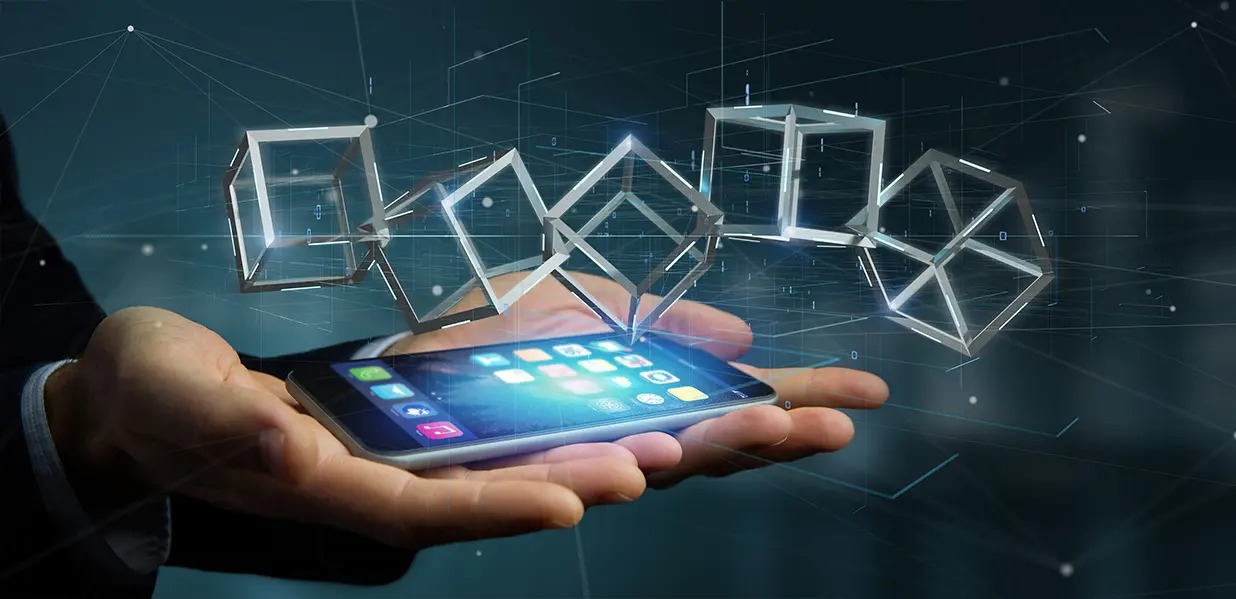IoT and Blockchain: Exploring the Synergy to Revolutionize the Future
Two giants of technology have arisen as change agents in our quickly evolving digital landscape: IoT and Blockchain. These two discoveries, each innovative in its own right, are now coming together to form a synergy that promises to transform how we interact with the world around us.
The Internet of Things, or IoT, is a concept that has grown in popularity in recent years. IoT is defined as the interconnection of common objects and gadgets over the internet. These items, which are integrated with sensors and communication capabilities, can collect and exchange data in order to accomplish tasks and increase efficiency.
In contrast, blockchain is a distributed ledger technology that has gained attention as the underlying architecture of cryptocurrencies such as Bitcoin. Its applications, however, go far beyond digital money. Blockchain is essentially a decentralized, tamper-resistant database in which transactions and data are securely recorded in a sequential chain of blocks.
The goal of this blog is to explore more into the intriguing relationship between IoT and Blockchain. We want to see how these two technologies can collaborate to solve problems, generate new possibilities, and shape the future. We will cover real-world use cases, prospective benefits, and the challenges that must be overcome for this fusion to realize its full potential in this blog.
How IoT and Blockchain Complement Each Other
The combination of IoT and Blockchain is analogous to putting two puzzle pieces together, resulting in a smooth and secure link between the physical and digital worlds. Here's how these two groundbreaking technologies work together:
Immutability and data integrity: IoT devices generate large amounts of data. The unchangeable ledger of blockchain assures that this data is tamper-proof and trustworthy. Once data is captured in a block, it cannot be changed or erased, making it ideal for preserving the integrity of IoT-generated data.
Improved Security: IoT devices are vulnerable to a variety of security risks. The decentralized nature of blockchain and its powerful cryptographic algorithms improve the security of IoT networks. It removes single points of failure, making it less vulnerable to attackers.
Smart Contracts: Blockchain introduces smart contracts, which are self-executing agreements that take action automatically when predefined circumstances are satisfied. In the context of IoT, this means that devices can conduct tasks autonomously, such as processing payments or activating certain capabilities when certain criteria are met.
Data Ownership and Privacy: Blockchain gives people more control over their data. IoT data can be stored on a blockchain with user-controlled access, giving individuals a choice over how their data is used.
Enhancing Data Security and Integrity with Blockchain in IoT
The security and integrity of data sent between devices and systems is one of the key problems in IoT. Blockchain technology is crucial in addressing these concerns:
Data Authentication: On a blockchain, IoT data can be cryptographically signed and timestamped, providing a safe and verifiable record of its origin and history.
Secure Device Identities: Blockchain may grant IoT devices unique, unforgeable identities, assuring their recognition and trust inside the network. This protects sensitive data from unauthorized devices.
Access Control Decentralized: Blockchain enables fine-grained access control. Data owners may control who has access to their data, ensuring privacy and compliance with data protection rules such as GDPR.
Immutable Audit Trails: The blockchain records any alterations or unauthorized attempts to access IoT data, establishing an immutable audit trail. This openness discourages malevolent behavior and makes forensic investigation easier after an incident.
Real-World Success Stories of IoT and Blockchain Integration
Supply Chain Management: Businesses like IBM and Walmart track the beginning and end of products as they move through blockchain technology in their supply chains. Consumers are now able to trace the provenance and authenticity of products thanks to IoT sensors that capture real-time data that is subsequently stored on the blockchain.
Health: IoT devices that collect patient health information include wearables and medical sensors. This data can be safely kept on a blockchain, allowing patients authority over their medical records and preserving data integrity—both of which are essential in healthcare settings.
Challenges And Concerns in the Synergy of IoT and Blockchain
IoT and blockchain's synergy may be exciting, but it is not without its difficulties and worries. We will see some of the most important problems that must be solved when combining these two technologies in this part.
Technical Challenges in Combining IoT and Blockchain
Processing Power: IoT devices, particularly those with low computational power, can find it difficult to carry out the intricate cryptographic processes necessary for Blockchain transactions. It is essential to find effective solutions to reduce this load or streamline the procedure.
Scalability: Because it takes so long to verify and log transactions in each block, blockchains like Bitcoin and Ethereum have trouble growing. Real-time applications may be hampered and IoT data processing may be delayed as a result.
Latency: Transaction confirmation can experience latency due to blockchain's consensus techniques, such as Proof of Work and Proof of Stake. Low latency is essential for time-sensitive IoT applications like industrial automation and driverless vehicles.
Interoperability: IoT devices may employ numerous communication protocols and come from many vendors. It is a difficult issue to guarantee flawless compatibility with Blockchain networks and IoT devices.
Scalability and Energy Efficiency Considerations
Blockchain Size: The size of the Blockchain ledger can become cumbersome as IoT devices continue to create data. To manage Blockchain size and preserve data integrity, strategies like sharding and pruning must be used.
Electricity Use: A lot of Blockchain networks, especially those that employ Proof of Work, use a lot of electricity. This can result in significant energy usage when integrated with IoT devices, which is unsustainable for devices that run on batteries or have limited resources.
Costs of transactions: When dealing with a significant amount of IoT data, blockchain transactions frequently incur fees that can become prohibitive. This may make it more difficult for some IoT applications to be profitable.
Privacy, Data Ownership, and Ethical Implications
Data Security: Storing IoT data on a public blockchain could lead to data privacy issues. Maintaining user confidence requires ensuring that sensitive data is adequately protected and anonymized.
Data Ownership: The question of who owns IoT data stored on a blockchain might be controversial. To prevent disagreements, data ownership and usage rights must be spelled out in smart contracts.
Regulatory Compliance: Data management and consent are subject to stringent obligations under data protection laws, such as the GDPR in Europe. To avoid legal ramifications, IoT and Blockchain installations must adhere to these rules.
The Modern World's Need for Secure and Transparent Systems
Systems that are transparent and safe are essential in a world that is becoming more and more digital. IoT and blockchain integration present a possible solution to these urgent issues.
Exploring the Growing Demand for Secure IoT Networks
Rising Cybersecurity Threats: As IoT devices proliferate, cybercriminals' attack surface has grown substantially. These gadgets frequently contain exploitable flaws. Secure IoT networks are critical for preventing data breaches and unwanted access.
Vital Infrastructure Protection: The Internet of Things (IoT) is essential for vital infrastructure such as energy grids, transportation networks, and healthcare. It is critical to ensure the security of these systems in order to avoid potential interruptions and dangers to public safety.
Concerns about Data Privacy: People are becoming more aware of the data collected by IoT devices and are concerned about their privacy. Secure IoT networks can provide people with trust that their data is being managed properly and securely.
Addressing the Trust Deficit in Digital Interactions
Trust in Digital Transactions: As our lives become more digital, trust in online interactions becomes increasingly important. The transparent and tamper-resistant feature of blockchain contributes to the restoration of trust in digital transactions, making it more difficult for bad actors to change data or participate in fraudulent operations.
Reducing Intermediaries: In many transactions, blockchain eliminates the need for intermediaries such as banks or notaries. This not only lowers expenses but also boosts trust by eliminating the possibility of human error or bias.
Openness in the Supply Chain: Consumers are expecting greater openness in the items they buy. End-to-end visibility in supply chains is enabled by blockchain, allowing consumers to trace the origin and travel of products, increasing trust in the things they buy.
Regulatory Developments and Compliance Requirements
Data Protection Regulations: Governments throughout the world are establishing rigorous data protection legislation in response to growing worries about data privacy. These regulations must be followed by IoT and Blockchain installations to ensure legal and ethical data processing. The European Union's General Data Protection Regulation (GDPR), for example, imposes stringent regulations on data management and user permission.
Financial rules: Blockchain technology is subject to financial rules and compliance standards in the financial sector. Companies that use Blockchain to provide financial services, such as cryptocurrencies and tokenized assets, must traverse a complicated regulatory context.
Smart Contracts and Legal Frameworks: The implementation of smart contracts on Blockchain systems presents legal and enforcement concerns. Legal frameworks will need to evolve to accommodate this technology as it evolves.
The Road Ahead: Future Possibilities
As IoT and Blockchain continue to advance, their synergy opens up a new universe of intriguing possibilities. In this section, we'll look at possible future developments and their far-reaching consequences.
Emerging Trends and Innovations in IoT and Blockchain Synergy
Edge Computing Integration: Integrating IoT and Blockchain at the edge, closer to where data is generated, can minimize latency and improve real-time decision-making. This tendency is especially useful in applications such as driverless vehicles and industrial automation.
Hybrid and Private Blockchains: While public blockchains provide openness, private and hybrid blockchains are emerging to address unique corporate demands. These provide you more control over your data while still taking advantage of Blockchain's security features.
Cross-Blockchain Integration: The capacity to transmit data and assets between Blockchains effortlessly is an area of current research and development. As a result, Blockchain networks may become more integrated and interoperable.
Enhanced Security Measures: As IoT security protocols and consensus processes in Blockchains evolve, the overall security of IoT and Blockchain systems will be strengthened, making them more resilient to cyberattacks.
Decentralized Finance (DeFi) and IoT: The combination of IoT and DeFi enabled innovative financial services such as microloans based on IoT device data or automated insurance payouts triggered by IoT events via Blockchain.
Industries Poised for Major Disruptions
Supply Chain Management: By combining IoT and Blockchain, end-to-end transparency in supply chains will be achieved. Consumers will have access to real-time data about the origin, quality, and delivery of products. This improves traceability and accountability while decreasing fraud and counterfeiting.
Healthcare: Wearable sensors and remote patient monitoring are examples of IoT devices in healthcare that can securely communicate data to Blockchain-based health records. This will increase data accuracy, patient privacy, and interoperability in healthcare.
Finance: IoT devices can give real-time data for lending and insurance risk assessment. Blockchain-based financial systems will enable faster, more transparent, and secure transactions while lowering costs.
Societal and Economic Implications of This Technology Fusion
Economic Growth: The convergence of IoT and Blockchain is expected to drive economic growth by introducing new business models, lowering operational costs, and enhancing efficiency across industries.
Job Opportunities: As the usage of IoT and Blockchain grows, there will be a greater demand for qualified people in these domains, ranging from Blockchain developers to IoT security experts.
Digital Inclusion: The widespread use of IoT and Blockchain technology has the potential to bridge digital divides by providing previously underserved people with access to safe and transparent digital services.
Environmental Impact: These technologies' greater energy efficiency and sustainability can have a positive environmental impact by lowering energy consumption and emissions.
Privacy and Ethical Considerations: Finding a happy medium between innovation and individual privacy will be a constant problem. Ethical considerations, particularly those pertaining to data consumption, will have a substantial impact on the societal impact of IoT and Blockchain integration.
Conclusion
In the ever-evolving landscape of technology, the convergence of IoT and Blockchain stands out as a paradigm-shifting force with the potential to shape the future in profound ways.
As we conclude our exploration of the IoT and Blockchain fusion, it's important to emphasize the need for continued research, development, and adoption of these technologies. The journey is far from over, and there is still much to discover and innovate.
Researchers, businesses, and policymakers must collaborate to address technical challenges, scalability issues, and regulatory complexities. Moreover, fostering a culture of innovation and encouraging startups and entrepreneurs to explore the possibilities of IoT and Blockchain will be instrumental in realizing their full potential.
So, are you ready to harness the immense potential of IoT and Blockchain technologies to revolutionize your business? Look no further than Infiniticube, your trusted partner in navigating the convergence of these game-changing technologies.
Why Choose Infiniticube?
Take advantage of our team's extensive knowledge and experience in IoT and Blockchain technology. We recognize that each industry is distinct. Our solutions are suited to your unique requirements and circumstances.
Our first priority is the protection of your data. We use strong security measures to protect your information and transactions. Our solutions scale smoothly to meet your expectations as your data and transaction volumes grow.
Navigate difficult regulations with comfort, knowing that our solutions are compliant with industry and worldwide standards. We believe in open communication, straightforward pricing, and a customer-focused approach.
Our success stories speak for themselves, showcasing our ability to transform novel ideas into workable solutions. Stay ahead of the curve by implementing solutions that not only address your current needs but also prepare you for future ones.
Ready to elevate your business with the power of IoT and Blockchain synergy? Don't miss out on the transformative potential. Contact us and let's shape the future together! You can book a call with our expert to discuss your IoT and Blockchain combined project.
 June 13, 2025
June 13, 2025
 Balbir Kumar Singh
Balbir Kumar Singh
 0
0
 May 30, 2025
May 30, 2025
 Balbir Kumar Singh
Balbir Kumar Singh
 0
0
 June 27, 2025
June 27, 2025
 Balbir Kumar Singh
Balbir Kumar Singh
 0
0
 June 13, 2025
June 13, 2025
 Balbir Kumar Singh
Balbir Kumar Singh
 0
0
 May 30, 2025
May 30, 2025
 Balbir Kumar Singh
Balbir Kumar Singh
 0
0
 June 27, 2025
June 27, 2025
 Balbir Kumar Singh
Balbir Kumar Singh
 0
0
 June 13, 2025
June 13, 2025
 Balbir Kumar Singh
Balbir Kumar Singh
 0
0
 May 30, 2025
May 30, 2025
 Balbir Kumar Singh
Balbir Kumar Singh
 0
0









Leave a Reply